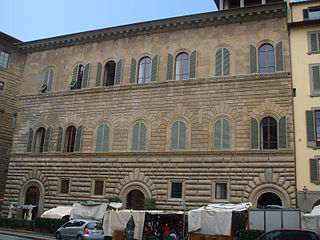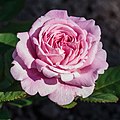
Lucca is a city and comune in Tuscany, Central Italy, on the Serchio, in a fertile plain near the Tyrrhenian Sea. It is the capital of the Province of Lucca. It is famous for its intact Renaissance-era city walls.

Giuseppe Puini was an Italian engineer and architect who worked in the neoclassical style in Tuscany, largely at Livorno, where he was largely responsible for the piazza that provides an urbanistic setting of the Cisternone (1842) and the Church of Sant’Andrea, and for the Church of San Giuseppe (illustration).

The historic centre of Florence is part of quartiere 1 of the Italian city of Florence. This quarter was named a World Heritage Site by UNESCO in 1982.

The Viali di Circonvallazione are a series of 6-lane boulevards surrounding the north part of the historic centre of Florence.

Ulisse Cambi was an Italian sculptor active in Tuscany during the 19th century.

Palazzo Gondi is a palace in Florence, Italy, located a block from Piazza della Signoria. It was built in 1490 under design by Giuliano da Sangallo, who was inspired by other major works of stately buildings in the city, such as Palazzo Medici and Palazzo Strozzi. Among the elements borrowed from these earlier works are the cube-shape set around a central courtyard, the ashlar sloping on each of three floors, and the arched windows.

Pietro Porcinai is renowned as one of the most outstanding Italian landscape architects of the twentieth century. He designed a wide variety of projects on the most diverse scales: gardens and public parks, industrial districts, hotels and tourist villages, motorways and agricultural areas. The hundreds of projects implemented in Italy and abroad comprise the most extraordinary “landscaped” gardens, perfectly integrated within the surroundings and so natural as to appear untouched by human hand.

Montegiovi is a village in Tuscany, central Italy, administratively a frazione of the comune of Castel del Piano, province of Grosseto, in the area of Mount Amiata. At the time of the 2001 census its population amounted to 168.

The Parco delle Cascine (Cascine Park) is a monumental and historical park in the city of Florence. The park covers an area of 160 hectares. It has the shape of a long and narrow stripe, on the north bank of the Arno river. It extends from the centre of Florence until the point where the Mugnone flows into the Arno.

Cimitero delle Porte Sante is a monumental cemetery in Florence located within the fortified bastion of the Basilica of San Miniato al Monte.

The following outline is provided as an overview of and topical guide to Florence:
Joseph Goedenhuyze or Goedenhuize was a Flemish botanist and naturalist, active in the court of the Grand Duchy of Tuscany. He was also known by the Italian name Giuseppe Casabona or more rarely Giuseppe Benincasa


























